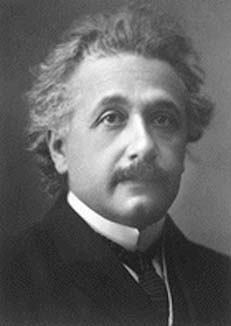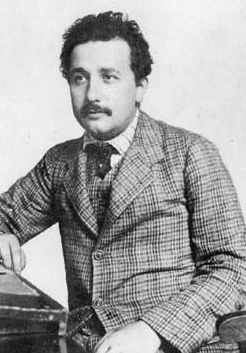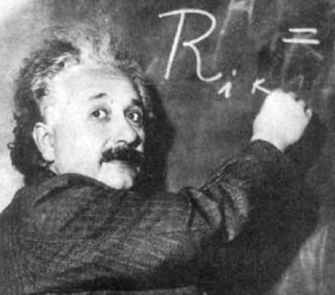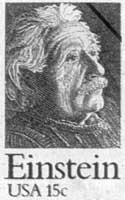|
ALBERT EINSTEIN 1879 - 1955
|
|||
|
Albert Einstein was born in Ulm, Württemberg, Germany on the 14th March 1879. Around 1886 Albert Einstein began his school career in Munich. As well as his violin lessons, which he had from age six to age thirteen, he also had religious education at home where he was taught Judaism. Two years later he entered the Luitpold Gymnasium and after this his religious education was given at school. He studied mathematics, in particular the calculus, beginning around 1891.
Albert
Einstein - genius mathematician
In 1894 Einstein's family moved to Milan, Einstein remained in Munich. In 1895 he failed an examination that would have allowed him to study for a diploma as an electrical engineer at the Eidgenössische Technische Hochschule in Zurich. Einstein renounced German citizenship in 1896 and was to be stateless for a number of years. He did not even apply for Swiss citizenship until 1899 which was granted in 1901.
Einstein attended the secondary school at Aarau, planning to use this route to enter the ETH in Zurich. While at Aarau he wrote an essay (for which was only given a little above half marks!) in which he wrote of his plans for the future, see :-
Einstein succeeded with his plan, graduating in 1900 as a teacher of mathematics and physics. One of his friends at ETH was Marcel Grossmann who was in the same class as Einstein. Einstein tried to obtain a post, writing to Hurwitz who held out some hope of a position but nothing came of it. Three of Einstein's fellow students, including Grossmann, were appointed assistants at ETH in Zurich but clearly Einstein had not impressed enough and still in 1901 he was writing round universities in the hope of obtaining a job.
He managed to avoid Swiss military service on the grounds that he had flat feet and varicose veins.
By mid 1901 he had a temporary job teaching mathematics at the Technical High School in Winterthur. Another temporary position teaching in a private school in Schaffhausen followed. Then Grossmann's father tried to help Einstein get a job by recommending him to the director of the patent office in Bern. Einstein was appointed as a technical expert third class.
Albert Einstein - patent clerk
Einstein worked in this patent office from 1902 to 1909, holding a temporary post when he was first appointed, but by 1904 the position was made permanent and in 1906 he was promoted to technical expert second class. While in the Bern patent office he completed an astonishing range of theoretical physics publications, written in his spare time without the benefit of close contact with scientific literature or colleagues. Einstein earned a doctorate from the University of Zurich in 1905 for a thesis "On a new determination of molecular dimensions", which he dedicated to Grossmann.
In the first of three papers, all written in 1905, Einstein examined the phenomenon discovered by Max Planck, according to which electromagnetic energy seemed to be emitted from radiating objects in discrete quantities. The energy of these quanta was directly proportional to the frequency of the radiation. This seemed to contradict classical electromagnetic theory, based on Maxwell's equations and the laws of thermodynamics which assumed that electromagnetic energy consisted of waves which could contain any small amount of energy. Einstein used Planck's quantum hypothesis to describe the electromagnetic radiation of light.
Einstein's second 1905 paper proposed what is today called the special theory of relativity. He based his new theory on a reinterpretation of the classical principle of relativity, namely that the laws of physics had to have the same form in any frame of reference. As a second fundamental hypothesis, Einstein assumed that the speed of light remained constant in all frames of reference, as required by Maxwell's theory.
Later in 1905 Einstein showed how mass and energy were equivalent. Einstein was not the first to propose all the components of special theory of relativity. His contribution is unifying important parts of classical mechanics and Maxwell's electrodynamics. The third of Einstein's papers of 1905 concerned statistical mechanics, a field of that had been studied by Ludwig Boltzmann and Josiah Gibbs.
After 1905 Einstein continued working in the areas described above. He made important contributions to quantum theory, but he sought to extend the special theory of relativity to phenomena involving acceleration. The key appeared in 1907 with the principle of equivalence, in which gravitational acceleration was held to be indistinguishable from acceleration caused by mechanical forces. Gravitational mass was therefore identical with inertial mass.
In 1908 Einstein became a lecturer at the University of Bern after submitting his Habilitation thesis Consequences for the constitution of radiation following from the energy distribution law of black bodies. The following year he become professor of physics at the University of Zurich, having resigned his lectureship at Bern and his job in the patent office in Bern.
By 1909 Einstein was recognised as a leading scientific thinker and in that year he resigned from the patent office. He was appointed a full professor at the Karl-Ferdinand University in Prague in 1911. In fact 1911 was a very significant year for Einstein since he was able to make preliminary predictions about how a ray of light from a distant star, passing near the Sun, would appear to be bent slightly, in the direction of the Sun. This would be highly significant as it would lead to the first experimental evidence in favour of Einstein's theory.
Einstein - at work
About 1912, Einstein began a new phase of his gravitational research, with the help of his mathematician friend Marcel Grossmann, by expressing his work in terms of the tensor calculus of Tullio Levi-Civita and Gregorio Ricci-Curbastro. Einstein called his new work the general theory of relativity. He moved from Prague to Zurich in 1912 to take up a chair at the Eidgenössische Technische Hochschule in Zurich.
Einstein returned to Germany in 1914 but did not reapply for German citizenship. What he accepted was an impressive offer. It was a research position in the Prussian Academy of Sciences together with a chair (but no teaching duties) at the University of Berlin. He was also offered the directorship of the Kaiser Wilhelm Institute of Physics in Berlin which was about to be established.
After a number of false starts Einstein published, late in 1915, the definitive version of general theory. Just before publishing this work he lectured on general relativity at Göttingen and he wrote:-
In fact Hilbert submitted for publication, a week before Einstein completed his work, a paper which contains the correct field equations of general relativity.
When British eclipse expeditions in 1919 confirmed his predictions, Einstein was idolised by the popular press. The London Times ran the headline on 7 November 1919:-
In 1920 Einstein's lectures in Berlin were disrupted by demonstrations which, although officially denied, were almost certainly anti-Jewish. Certainly there were strong feelings expressed against his works during this period which Einstein replied to in the press quoting Lorentz, Planck and Eddington as supporting his theories and stating that certain Germans would have attacked them if he had been:-
During 1921 Einstein made his first visit to the United States. His main reason was to raise funds for the planned Hebrew University of Jerusalem. However he received the Barnard Medal during his visit and lectured several times on relativity. Einstein received the Nobel Prize in 1921 but not for relativity rather for his 1905 work on the photoelectric effect. In fact he was not present in December 1922 to receive the prize being on a voyage to Japan. Around this time he made many international visits. He had visited Paris earlier in 1922 and during 1923 he visited Palestine. After making his last major scientific discovery on the association of waves with matter in 1924 he made further visits in 1925, this time to South America. Among further honours which Einstein received were the Copley Medal of the Royal Society in 1925 and the Gold Medal of the Royal Astronomical Society in 1926.
Einstein - postage stamp
Niels Bohr and Einstein were to carry on a debate on quantum theory which began at the Solvay Conference in 1927. Planck, Niels Bohr, de Broglie, Heisenberg, Schrödinger and Dirac were at this conference, in addition to Einstein. Einstein had declined to give a paper at the conference and:-
Indeed Einstein's life had been hectic and he was to pay the price in 1928 with a physical collapse brought on through overwork. However he made a full recovery despite having to take things easy throughout 1928. By 1930 he was making international visits again, back to the United States. A third visit to the United States in 1932 was followed by the offer of a post at Princeton. The idea was that Einstein would spend seven months a year in Berlin, five months at Princeton. Einstein accepted and left Germany in December 1932 for the United States. The following month the Nazis came to power in Germany and Einstein was never to return there.
During 1933 Einstein traveled across Europe visiting Oxford, Glasgow, Brussels and Zurich. Offers of academic posts which he had found it so hard to get in 1901 were now plentiful. In 1940 Einstein became a citizen of the United States, but also kept his Swiss citizenship. He made many contributions to peace during his life. In 1944 he made a contribution to the war effort by hand writing his 1905 paper on special relativity and putting it up for auction. It raised six million dollars, the manuscript today being in the Library of Congress.
Einstein became unwell in 1949. A spell in hospital helped him recover but 1950 he had drawn up his will. He left his scientific papers to the Hebrew University in Jerusalem, a university which he had raised funds for on his first visit to the USA, served as a governor of the university from 1925 to 1928 but he had turned down the offer of a post in 1933 as he was very critical of its administration. One more major event was to take place in his life. After the death of the first president of Israel in 1952, the Israeli government decided to offer the post of second president to Einstein. He refused but found the offer an embarrassment since it was hard for him to refuse without causing offence.
One week before his death Einstein signed his last letter. It was a letter to Bertrand Russell in which he agreed that his name should go on a manifesto urging all nations to give up nuclear weapons. It is fitting that one of his last acts was to argue, as he had done all his life, for international peace.
Einstein
died in Princeton and was cremated at Trenton, New
Jersey, USA at 4 pm on 18 April 1955 (the day of his death). His ashes were scattered at an undisclosed
place.
ON CREATIVITY: INVENTIVE GENIUS ALBERT EINSTEIN sums up creativity in some of his more famous quotes:
* A person who never made a mistake never tried anything new.
* We cannot solve our problems with the same thinking we used when we created them.
* The true sign of intelligence is not knowledge but imagination.
*
Imagination is more important than knowledge. * Logic will get you from A to B. Imagination will take you everywhere.
* If we knew what it was we were doing, it would not be called research, would it?
* You have to learn the rules of the game. And then you have to play better than anyone else.
* The only real valuable thing is intuition.
* If the facts don't fit the theory, change the facts.
* Intellectuals solve problems, geniuses prevent them.
* The only thing that interferes with my learning is my education.
* Most people say that it is the intellect which makes a great scientist. They are wrong: it is character.
* True art is characterized by an irresistible urge in the creative artist.
* I am enough of an artist to draw freely upon my imagination.
* To raise new questions, new possibilities, to regard old problems from a new angle, requires creative imagination and marks real advance in science.
* We shall require a substantially new manner of thinking if mankind is to survive.
* Learn from yesterday, live for today, hope for tomorrow. The important thing is not to stop questioning.
Honours
awarded to Albert Einstein Nobel Prize Awarded 1921 Fellow of the Royal Society Elected 1921 Royal
Society Copley Medal
Awarded 1925 AMS
Gibbs Lecturer
1934 The Times (Obituary) Albert
Einstein Online Connections with Finlay Freundlich The
quantum age begins
INVENTORS A - Z
The ultimate Robot Boat. Solarnavigator uses an advanced SWASH hull as the platform to mount the world's first autonomous circumnavigation. A successful expedition could pave the way for improved safety at sea.
|
|||
|
This website is copyright © 1991- 2013 Electrick Publications. All rights reserved. The bird logo and names Solar Navigator and Blueplanet Ecostar are trademarks ™. The Blueplanet vehicle configuration is registered ®. All other trademarks hereby acknowledged and please note that this project should not be confused with the Australian: 'World Solar Challenge'™which is a superb road vehicle endurance race from Darwin to Adelaide. Max Energy Limited is an educational charity working hard to promote world peace.
|
|||
|
AUTOMOTIVE | BLUEPLANET BE3 | ELECTRIC CARS | ELECTRIC CYCLES | SOLAR CARS | SOLARNAVIGATOR |




